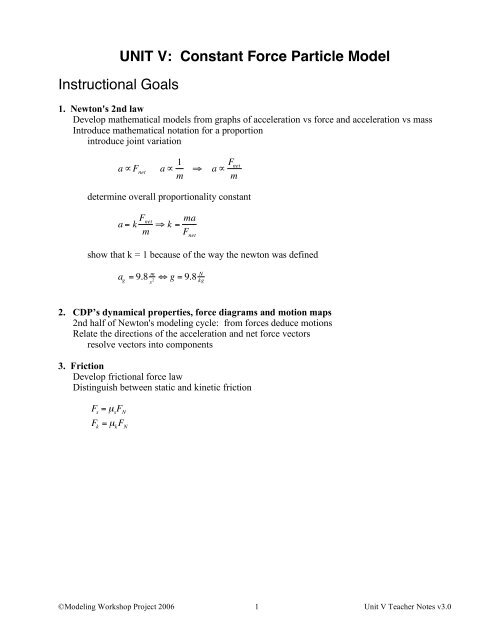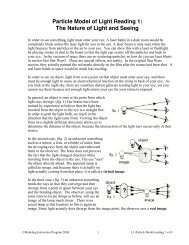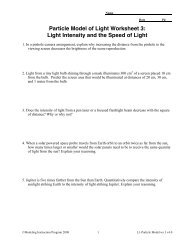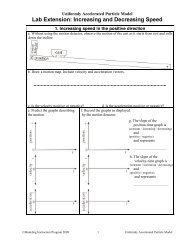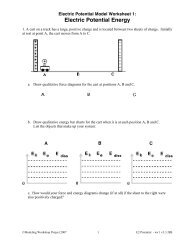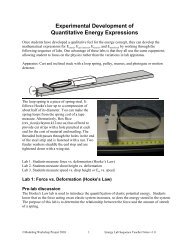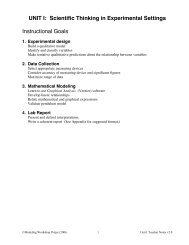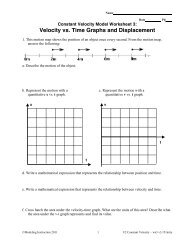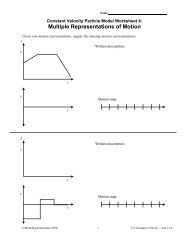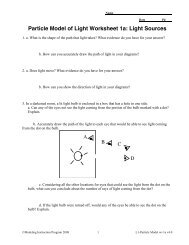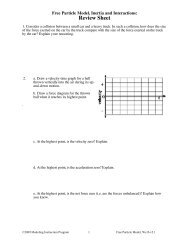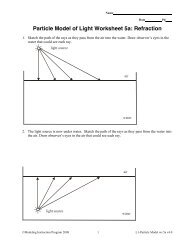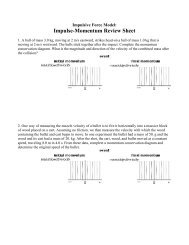UNIT V: Constant Force Particle Model ... - Modeling Physics
UNIT V: Constant Force Particle Model ... - Modeling Physics
UNIT V: Constant Force Particle Model ... - Modeling Physics
You also want an ePaper? Increase the reach of your titles
YUMPU automatically turns print PDFs into web optimized ePapers that Google loves.
Instructional Goals<br />
<strong>UNIT</strong> V: <strong>Constant</strong> <strong>Force</strong> <strong>Particle</strong> <strong>Model</strong><br />
1. Newton's 2nd law<br />
Develop mathematical models from graphs of acceleration vs force and acceleration vs mass<br />
Introduce mathematical notation for a proportion<br />
introduce joint variation<br />
a "F net<br />
a " 1 m # a " F net<br />
m<br />
determine overall proportionality constant<br />
a = k F net<br />
m " k = ma<br />
F net<br />
show that k = 1 because of the way the newton was defined<br />
a g<br />
= 9.8 m s 2<br />
" g = 9.8 N kg<br />
2. CDP’s dynamical properties, force diagrams and motion maps<br />
2nd half of Newton's modeling cycle: from forces deduce motions<br />
Relate the directions of the acceleration and net force vectors<br />
resolve vectors into components<br />
3. Friction<br />
Develop frictional force law<br />
Distinguish between static and kinetic friction<br />
F s<br />
= µ s<br />
F N<br />
F k<br />
= µ k<br />
F N<br />
©<strong>Model</strong>ing Workshop Project 2006 1 Unit V Teacher Notes v3.0
Overview<br />
In this unit, students learn the second half of Newton's <strong>Model</strong>ing Cycle:<br />
a) from motions (read: changes in velocity) infer forces<br />
b) from forces deduce motions<br />
Students should be able to correctly describe the kinematic behavior of an object from the force<br />
diagram. Typically, students are expected to be able to determine the net force, then the value of<br />
the unknown applied force from a description of the object's kinematic behavior.<br />
In the deployment worksheets reinforce the practice of drawing force diagrams as the first step in<br />
preparing a solution to the problem. Make sure that these diagrams faithfully represent the<br />
forces (long-range and contact) that act on the object. In whiteboard presentations try to induce<br />
students to recognize multiple approaches to problems dealing with systems that consist of more<br />
than one object.<br />
Instructional Notes<br />
Modified Atwood's machine lab<br />
Apparatus<br />
wheeled carts dynamics carts glider<br />
wood ramps PASCO tracks airtracks<br />
pulleys with clamps<br />
balance for mass measurement<br />
hangers for slotted weights (or equivalent)<br />
spring scales (newton calibration)<br />
photogates<br />
ULI Timer, Logger Pro, or Data Studio software<br />
Graphical Analysis<br />
Pre-lab discussion<br />
• Allow a suspended mass to tow a cart (glider) across the track; ask students to observe its motion.<br />
We've already established that a force is required to produce an acceleration. We just haven't<br />
quantified the relationship. Rather than brainstorming general observations, ask them to identify<br />
other factors that might affect the acceleration of the cart. To proceed, the list must include mass,<br />
amount of friction, and amount of force used to tow cart.<br />
• Ask them for ideas on how to minimize the effect of friction. After some discussion, they will<br />
hopefully come to the idea of inclining the ramp slightly to compensate for friction.<br />
• Ask them how to measure the acceleration of the cart. While they cannot measure it directly, there<br />
are at least two ways to do determine the acceleration. One can calculate it from rearrangement of<br />
the kinematical model "x = 1 2 at 2 . (Note: The use of this model requires the assumption that<br />
acceleration is constant. The rationale for such an assumption could be based on an "extra credit"<br />
©<strong>Model</strong>ing Workshop Project 2006 2 Unit V Teacher Notes v3.0
lab.) Another method is to allow a picket fence affixed to the cart to pass through a photogate. The<br />
slope of the velocity vs time graph yields the acceleration.<br />
• The dependent variable is the acceleration of the cart.<br />
• The independent variables are the mass of the cart/hanger system and the force used to pull the cart.<br />
• Make sure to stress that the mass that is being accelerated is the total mass of the system (the cart<br />
and hanging mass are connected, so must accelerate at the same rate).<br />
Lab performance notes<br />
• Use small mass hangers (e.g. 5g) and change by 10 to 20g increments.<br />
• Increase cart mass by 0.2 - 0.5 kg increments.<br />
• Adjust the angle of incline so that the cart can move at a constant speed with a very small initial<br />
push.<br />
• Convince students that they must transfer mass from the cart to the hanger in order to keep the total<br />
mass constant when they vary the force.<br />
• Convert the hanging mass to newtons.<br />
• See sample graphs in Figures 1, 2, and 3.<br />
Post-lab discussion<br />
Figure 1 Figure 2 Figure 3<br />
• Since the units of slope are not intuitive, focus on proportionalities.<br />
• Discuss the combination of two proportionalities into one:<br />
a "F net<br />
a " 1 m # a " F net<br />
m<br />
• Turn the proportionality into an equation; rearrange to solve for k.<br />
a = k F net<br />
m " k = ma<br />
F net<br />
• Substitute values from regression line to solve for k. With luck, students' values should cluster<br />
around 1.0. Now is the time to point out that the slope of force of gravity vs mass (9.8 N/kg) and the<br />
slope of velocity vs time (9.8 m/s 2 ) have the same numerical value due to the way the newton was<br />
defined.<br />
©<strong>Model</strong>ing Workshop Project 2006 3 Unit V Teacher Notes v3.0
Worksheet 1<br />
Quiz 1<br />
Worksheet 2<br />
Quiz 2<br />
Friction (two approaches)<br />
1. Demo/discussion<br />
At this point you must decide to what depth you wish<br />
to treat friction. If you wish to perform a<br />
demonstration, you can use a force probe and motion<br />
detector with a "sled" and various masses. Load<br />
Logger Pro (MacMotion) or Data Studio software and<br />
set up the motion detector. Calibrate the force probe,<br />
and then re-zero it in the horizontal position.<br />
If you steadily increase the pull on the block, the<br />
force vs time graph should show a steady increase<br />
until the applied force exceeds the force of static<br />
friction and the object moves at constant velocity (use<br />
motion detector to check this). One can obtain<br />
the coefficients of static and kinetic friction<br />
from the maximum and steady state values of<br />
applied force and the normal force.<br />
If you wish a more thorough treatment, read the<br />
following<br />
2. Friction Lab<br />
Apparatus<br />
Pre-lab discussion<br />
• Students are asked to make observations of an object being dragged along a surface. All<br />
observations are accepted. Friction is likely to be among the observations.<br />
• Students are asked what affects the frictional force on the object and the surface. Ask what can be<br />
measured or otherwise described. Things like speed, weight, area of contact, and types of surfaces<br />
are important for students to mention.<br />
• Guide students to the notion that it is the “support” force (normal force), rather than the force of<br />
gravity on the object, that really is the significant factor. Showing a situation in which the two are<br />
noticeably different can lead students to articulate this conclusion.<br />
©<strong>Model</strong>ing Workshop Project 2006 4 Unit V Teacher Notes v3.0
• The possible difference between static and kinetic friction may be elicited by using a rather massive<br />
box on the desk. The static frictional force may be seen to be a variable dependent on the pulling<br />
force applied by the student, on surface area, on surface type, and on support force. Therefore, static<br />
friction can be included in this experiment as desired. It may be desired to focus student attention on<br />
the maximum static friction force as the significant variable which can be graphed against the<br />
independent variables other than pulling force, because it is the single unique value that we can<br />
associate with static friction.<br />
• Materials available are shown to students. <strong>Force</strong> scales, objects and surfaces, mass sets, paper,<br />
plastic, and sandpaper (to change surface types), a motor to drag objects along at various speeds, and<br />
a photogate system to time the object as it passes, and a meter stick should be among the apparatus<br />
available. Perhaps small pieces of wood of varying area having sandpaper, plastic, and paper<br />
attached can ride along with the object and serve as means to change surface area.<br />
• If felt is one of the materials used for the surface type variable, some dependence on surface area<br />
may be observed. It appears that the increased mashing of the felt when a smaller surface area is<br />
used produces a change in the surface character. Therefore, felt may be used as desired. It depends<br />
on what the instructor wants the students to think about.<br />
Lab performance notes<br />
• A central part of this experiment will be the control of variables. Naturally, no help should be given<br />
students regarding this other than asking them to explain what they are doing and why and to refer<br />
lost students to others who are not so lost. The frictional force will be plotted against support force,<br />
surface area, speed, and type of surface, so there are several variables.<br />
• The frictional force vs surface type graph is of a different kind than previous graphs, since surface<br />
type is not a continuous variable; a bar graph will be needed, but expect all kinds of graphs to be<br />
made. Through discussion about the meanings of incorrectly constructed graphs, the significance of<br />
bar graphs can become clear to students. Let them make the graphs they wish, but discuss them<br />
carefully in the post-laboratory discussion. It can be helpful during the laboratory session to find<br />
students making inappropriate graphs to present their results later.<br />
Post-lab discussion<br />
• Develop the concepts that the friction force: (a) is independent of the contact surface area; (b)<br />
depends on the normal force (not always weight) and is different for static versus kinetic situations;<br />
and (c) depends on the types of surfaces in contact.<br />
• A slight dependence of frictional force on speed may be detected. Indicate that the study of velocitydependent<br />
frictional effects is usually reserved for more advanced courses.<br />
©<strong>Model</strong>ing Workshop Project 2006 5 Unit V Teacher Notes v3.0
• A fairly linear relationship should be apparent from the force of friction vs support force graph. The<br />
coefficient of kinetic friction is introduced here.<br />
• No mathematical expression will be forthcoming from the graphical model of frictional force vs<br />
surface type. It should be concluded that each pair of surfaces will have its peculiar coefficient of<br />
friction.<br />
• Aim for student application of the formulas: F s ! µ s F N<br />
F k<br />
! µ k<br />
F N<br />
Worksheet 3<br />
Worksheet 4<br />
Unit V Test<br />
©<strong>Model</strong>ing Workshop Project 2006 6 Unit V Teacher Notes v3.0


